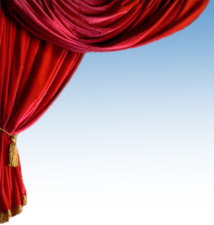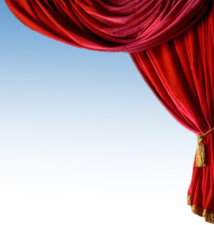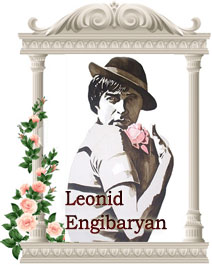THE HISTORY OF CIRCUS
Circus as one of the ancient forms of the folklore and mystic art was the most accepted form of theatre and was called
tatr or
teatron in Armenian Middle Ages. The oldest of the few literary evidences relates to the fifth century. Eznik Koghbaci writes: “Someone growing bear’s right hand, trains him as a dancer and likening it to human nature, soften his savage temper. And others, however, catching monkeys, train them as clowns and pranksters. Some also caught royal snakes and various magic pet them to people destroying their deadly poison".
In the
"Armenian History" Pavstos Buzand a bishop Hovnan is in the form of a palace jester. He crawls on all fours before the king taking his position sitting camel. In the Cilician sources there is information about equestrian circus game. In Middle Ages the circus was a place of shows for power, harden struggle and wrestling.
From the traditional genres of the ancient Armenian circus tightrope walking is the most resilient and surviving. This is a form of symbolic and beautiful reproduction of objective reality, adapted to the Christian conception of life.
Rope-imagined as an adherent of the hero-a miracle-worker St. Karapet, and his partner represented the earthly and reprehensible. Symbolization of unity and contradiction, the lofty and low, the divine and human led here to a variety of subject and language provisions. Medieval Circus in juggling has proved all the features of the semantics and aesthetics. Equilibration gives a more tangible idea of the circus, obvious traces of which can be traced to the medieval miniatures.
These chronicles and traditional reality presented the Armenian medieval and new circus in the form of a mobile theater. Verbal facts in the speech Hovnan Mandakuni suggest just the existence of Armenian circus building.
The word "teatron" in medieval dictionaries treated as "gaming arena", the situation (position) players, (Matenadaran: Repository of Ancient Manuscripts, Yerevan NN 450, 623).
In terms of prosperity during the reign of dynasties of Bagratuni, Artzruni (IX-XI centuries) in Cilician Armenia, perhaps, were the structure of this kind which may reproduce the linguistic evidence of an ancient memory. Trails of the medieval circus have been saved also in the folklore, just at cycle of Shrovetide. They are games like rope game, walking with foot chains, ram-fight, cock-fight, buffalo-fight and barba accompanying with music (kokh).
With the destroying of the medieval cities and political life the professional circus art has partly disappeared, partly has immigrated from his flora and fauna and partly has been mixed in folk languages. In Europe medieval tradition of calling the circus theatre has been continued till 1806, when with the Napoleon’s decree French manej parlours and groups were called circus (circus-cycle), portal parlours and groups theatre.
In Armenian middle age, in XIX century tatr and teatron names were saved with their corresponding meanings. Thus in 1846, the Armenian circus opened in K. Polsh as was called “Aramyan theatre” simultaneously having centre showing and portal, excentric musical-dramatic effect. “Aramyan theatre” founded a tightrope walker, heavyweight sportsman and actor H. Gasparyan, who was trained in a French group of circus. The theatre had a wooden building, large hall with a manej and a stage, constant group (pantomimes, equilibrists, dancers, dramatists), European style orchestra and composer-director (K. Papazyan).
The shows took place places with large program, consisting of 2-3 different parts of circus and balletic, pantomimic and dramatic. Circus part was consisting of power, surprise and fearful shows, technically difficult and theatrical tightrope games (dancing, fight, fire and feast on the rope took place Italian dancer (Liza, Hayte, Rose, Mikelia) took place in balletic part, in the pantomimic intermedium- H. Gasparyan, A. Minasyan, M. Bambukchyan, G. Chilinkiryan and others.
Adventures, melodrama and historical tragedies were presented in dramatic part, where the whole theatrical group took place (up to 26 person), including Armenian girls (Taguhi, Mari, Antik). Italian and French circus troupes of K. Polis couldn’t stand and were closed and the atmosphere was left to “Aramyan theatre”.
1849 theatrical period H. Gasparyan’s circus gave shows in Tivlis , where he had many performances in Tbilisi where Hakob built special building for this group, 1000 places, 72 double flours with magnificent rooms. Then circus had tours in Armenian habited places of Georgia, Poti, Qutais, Suram, Gori, Mckhet. In 1850 in summer the group gave shows in Yerevan (Cakhi meidan yard), in Echmiatsin, after it left for Naghijevan, from there Tavriz, again Tivlis, till the end of 1853.
Theatre’s further action was continued in K. Pools, where Mkrtich Chezairyan built a new construction with amfi theatre and rooms. “Aramyan theatre” acted 1.20 years until the end of 1866 as the first and the only professional circus in the Near East.
Doctor of artistry of RA, a journalist member of National
Academy of Science, Henrik Hovhanisyan.



